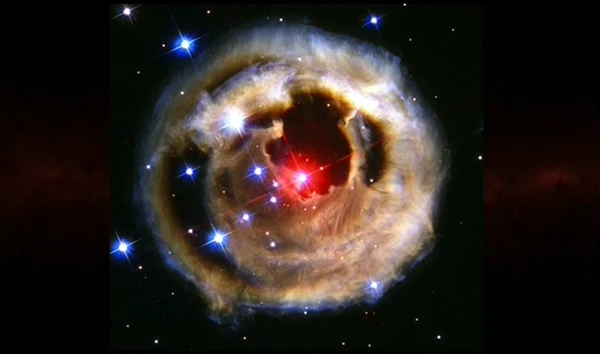
In January 2002, a star located in the constellation Monoceros, about 20,000 light-years away, suddenly increased in brightness: V838 Monocerotis became 10,000 times brighter than the Sun. Its flare resembled that of a supernova, but no gravitational collapse or gamma rays followed. The star survived its outburst. This event, known as a luminous red nova, raised many questions about the physics of stellar envelopes and the dynamics of stellar mergers.
The most spectacular phenomenon associated with V838 Monocerotis was the propagation of a light echo. Within months, the explosion's light reflected off thin layers of surrounding dust, creating the illusion of superluminal expansion. In reality, the apparent velocity > c was only a perspective effect: the light was successively illuminating layers of matter at different distances. This echo allowed astronomers to build a three-dimensional map of the local interstellar medium with unprecedented precision.
Initial hypotheses suggested a thermal eruption similar to that of a Mira variable or an instability in a supergiant’s envelope. However, spectroscopic observations revealed a rapid cooling of the photosphere, from about 7000 K down to below 2000 K in a few months, indicating a massive expansion rather than a destructive explosion. Today, the most accepted scenario is that of a stellar merger between a B-type star and a smaller companion.
N.B. :
Mira (ο Ceti) is a red giant variable star about 300 light-years away. Its brightness varies by a factor of 1000 over a 332-day period due to internal pulsations typical of stars on the Asymptotic Giant Branch (AGB).
According to Romano Corradi (1966–) and Howard Bond (1941–), the event resulted from the coalescence of a binary system. As the secondary star spirals inward, friction and mass accretion release energy, producing a rapid expansion and intense optical emission, without reaching the conditions for core collapse (\(P_{\mathrm{grav}} < P_{\mathrm{fusion}}\)). This partial merger transformed V838 Monocerotis into a cool red supergiant surrounded by recently ejected dust layers.
The study of V838 Monocerotis has provided insight into energy transfer processes in binary systems and the formation of common envelopes. These phenomena play a key role in galactic dust distribution and stellar population evolution. They also demonstrate that the death of a star is not always a terminal explosion: some are reborn in another, unstable yet active form.
| Property | V838 Monocerotis | Type II Supernova | Key Difference |
|---|---|---|---|
| Origin | Merger of two stars | Gravitational collapse of a massive star | No destruction of the stellar core |
| Maximum temperature | ≈ 7000 K | > 109 K | Cooler and slower explosion |
| Duration of brightness | Several months | Several weeks | More extended evolution over time |
| Remnant | Surviving red supergiant | Neutron star or black hole | No compact remnant |